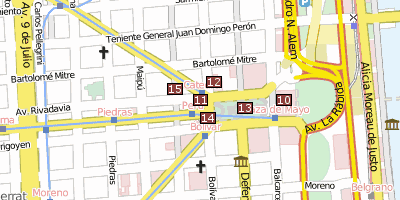Rathaus Buenos Aires, Buenos Aires
Beschreibungen und Fotos zu Rathaus Buenos Aires in Buenos Aires
Besuchen Sie auch Fotos Rathaus Buenos Aires, unseren Stadtplan-Rathaus Buenos Aires oder Hotels Nähe Rathaus Buenos Aires.
Buenos Aires City Hall is the executive seat of government of the Argentine capital.
Building
The 1880 Federalization of Buenos Aires was followed by a boom in foreign trade and European immigration, and in 1890, Mayor Francisco P. Bollini commissioned the construction of a new city hall. The building would replace what had been the city government's offices since 1860 - the second floor of police headquarters; the city had grown dramatically since then, and the space had become inadequate.
Bollini's announced project had been immediately preceded by the Panic of 1890, however, and the effect of this crisis on the city's leading source of tax revenue British investment, led to plans of a relatively modest scale. Among the cost-saving measures was the city's enlistment of the Assistant Minister of Public Works, Juan Cagnoni, as chief architect, as well as the decision to build on the site of the outmoded police headquarters. Decorative tilework and chandeliers from the adjacent Zuberbühler house, which had recently been expropriated to make way for the Avenida de Mayo, were likewise salvaged for use in the upcoming city hall (where they remain to the present day).
The cornestone laying ceremony was held on New Year's Eve 1890, for which the Mayor contributed a time capsule which included the construction permit among other mementoes. The works themselves cost the city a modest 150,000 pesos (US$ 75,000), and were completed in 1892. Inaugurated in March 1893, the new city hall originally housed 860 m² (9,200 ft²), and was only a little more spacious than the earlier offices. This problem was ultimately resolved by the 1911 acquisition of an adjacent residential lot, which allowed the expansion of the city hall by nearly double. Designed in the same Second Empire style with which Cagnoni designed the first part, the engineering firm of Bonneu Ibero, Parodi & Figini completed the annex in 1914.
Government
The 1880 Federalization of Buenos Aires, enacted in a bid to end the internecine warfare between those who favored a united Argentina with a strong central government (Unitarios) and Buenos Aires Province leaders who favored an independent nation of their own (Federales), resulted in President Julio Roca's passage in 1882 of National Law 1260, which created the presidential prerogative of the appointment of the Mayor of Buenos Aires (though with a locally-elected city council).
This remained the city's governing structure in 1993, when former President Raúl Alfonsín prevailed on his successor, President Carlos Menem, to agree to a limited devolution of governing powers to the city (the Olivos Pact). Accordingly, the 1994 reform of the Argentine Constitution included article 129, which guaranteed Buenos Aires greater self-governance. The Indentente (appointed Mayor) was replaced by a Jefe de Gobierno (elected Mayor), and the city council by the Buenos Aires City Legislature. Shortly before the historic, June 30, 1996, elections to these posts, however, a senior Peronist Senator, Antonio Cafiero, succeeded in limiting the city's autonomy by advancing National Law 24.588, which reserved control of the 25,000-strong Policía Federal (the federally-administered city police), the Port of Buenos Aires and other faculties to the national government.
The controversial bill, signed in 1996 by President Menem, remained a sticking point between successive Presidents (most of whom have been Peronist) and Buenos Aires Mayors (none of whom have been). A 2005 agreement on principles between Mayor Aníbal Ibarra and President Néstor Kirchner was followed by the modification of the especially contentious article 7, which denied the city its own, local police force, in 2007 - though the "Cafiero Law" otherwise remains in force. Efforts since 2007 by Mayor Mauricio Macri to declare it unconstitutional have thus far failed, and though the Mayor inaugurated a Metropolitan Police, issues of revenue sharing for its financing remain pending.
Übersicht der Bewertungen Rathaus Buenos Aires
Von den vorliegenden Sehenswürdigkeitsbewertungen über die Sehenswürdigkeit ergibt sich die Gesamtbewertung
- Das Teatro Colón (spanisch für Kolumbus-Theater) ist das bekannteste Theate...
- Die Casa Rosada, die auch Präsidentenpalast genannt wird, befindet sich in...
- Calle Florida - Florida is a pedestrian street in downtown Buenos Aires, Argen...
- Museo Nacional de Bellas Artes - The National Museum of Fine Arts (MNBA) is a...
Sehenswürdigkeiten von Buenos Aires:
|
|
Augenblicklich angesagte Buenos Aires-Hotels
Hotelangebote buchen
Buchen Sie ein passendes Angebot jetzt auf Citysam ohne Buchungsgebühr. Kostenfrei zu jeder Buchung erhält man über Citysam einen Download Guide!
Stadtplan Buenos Aires
Besuchen Sie Buenos Aires oder die Region über unsere hilfreichen Stadtpläne von Buenos Aires. Direkt per Luftaufnahme findet man interessante Attraktionen und buchbare Hotelangebote.
Sehenswürdigkeiten
Beschreibungen zu Obelisk von Buenos Aires, La Boca, Argentinischer Nationalkongress, Catedral Metropolitana de Buenos Aires und jede Menge andere Sehenswürdigkeiten erfahren Sie innerhalb unseres Reiseführers dieser Stadt.
Hotels von Citysam
Passende Unterkünfte und Gästehäuser jetzt suchen sowie reservieren
Diese Unterkünfte findet man in der Umgebung von Rathaus Buenos Aires und sonstigen Sehenswürdigkeiten wie Teatro Colón, Argentinischer Nationalkongress, Obelisk von Buenos Aires. Außerdem gibt es Hotelsuche insgesamt 594 weitere Hotelangebote. Alle Reservierungen inklusive gratis PDF Reiseführer zum Sofortdownload.












